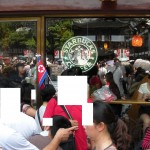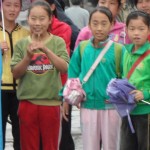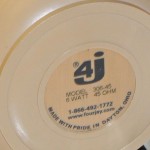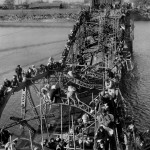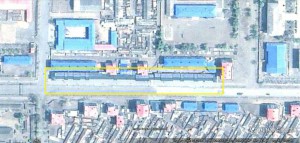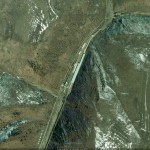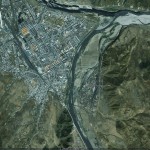
Low-resolution satellite image of the Tumen-Namyang border.
UPDATE: Here is the original story in Asahi:
Goods from North Korea are being traded freely in a thriving market that opened last week in a Chinese city near the border with the reclusive state, according to sources from the region.
Marine products–frozen squid is a specialty–are prominently displayed, the sources said.
The market in Tumen, Jilin province, opened on Oct. 13. It appears to be the latest development in growing economic exchanges between Beijing and Pyongyang following a visit to China by North Korean leader Kim Jong Il in August and moves to secure a smooth transition of power to his third son, Kim Jong Un, the sources said.
Earlier this month, it was learned that Tumen is preparing to accept an influx of cheap labor from North Korea.
The market, which has a total space of about 10,000 square meters, is located on the banks of the Tumenjiang (Tumengang in Korean) river, which serves as the common border between the two countries.
Currently, the market is open twice a week, but there are plans for it to become a daily feature in the near future, the sources said.
According to the sources, Chinese residents in Tumen, which is located inside the Yanbian Korean Autonomous Prefecture within Jilin province, can obtain travel permits to North Korea by presenting identification.
With entry permits in hand, the Chinese are able to cross the river to Namyang, where they are allowed to buy products at designated areas, provided they return to China the same day.
Purchases worth up to 8,000 yuan (about 96,000 yen, or $1180) are treated as duty-free and can be sold at the Tumen market.
The sources said about 150 people showed up at the market on Oct. 13, including merchants as well as ordinary citizens.
North Korean marine products, whose prices are considerably cheaper than Chinese products, dominated the goods on display.
A Tumen city official declined to provide details on the market, saying “it is still in the experimental stage.”
But sources suggest that the market is part of efforts to enhance commerce in northeastern China, which has trailed in economic development compared with coastal regions in the rest of the country.
The market also provides a crucial means for North Korea to earn hard currency by freely selling goods in China.
The idea of setting up such a market is not entirely new. In 2005, the Jilin provincial government authorized the opening of a market as a means to revitalize the border region. However, the project had to be shelved after an international uproar over an underground nuclear test conducted by North Korea.
The plan resurfaced after the region encompassing the Tumenjiang river district and the cities of Jilin and Changchun was designated in 2009 as a development and deregulation promotion zone, the first such national-level development project for a border region.
Jilin province has since taken strident measures to encourage exchanges with North Korea with which it shares a sprawling border.
Sun Zhengcai, a top Chinese Communist Party official from Jilin province, joined a delegation of party officials to North Korea this month on the occasion of the 65th anniversary of the founding of the Workers’ Party of Korea, and is believed to have engaged in talks with the North Korean side on boosting commerce.
The opening of the market follows reports that North Korean laborers may soon be able to work in Chinese factories in Tumen legally, and that Chinese businesses have acquired rights to use and develop wharf facilities at the ports of Rajin and Chongjin in northern North Korea.
Chinese businesses are also reportedly moving toward participating in the construction of infrastructure such as railways and roads to access the ports.
ORIGINAL POST: According to KBS:
A Japanese daily says a “free market” operated by North Korean and Chinese citizens has opened near the Tumen River, which flows between China and North Korea.
The Asahi Shimbun said Wednesday that the market was established in the city of Tumen in China’s Jilin Province a week ago.
The paper said the ten-thousand-square-meter market allows Chinese people to buy up to eight-thousand yuan worth of North Korean goods tax-free each day for resell in China.
The paper said that on the day the market opened last Wednesday, some 150 Chinese purchased tax-exempt frozen squid from North Koreans at the market for resell.
The Asahi said North Korea and China are apparently expanding bilateral economic exchanges following North Korean leader Kim Jong-il’s visit to China in August, citing Chinese firms’ recent move to employ North Korean workers.
Unfortunately high-resolution satellite imagery of the area is not yet available on Google Earth, but we do know that Namyang contains 1 of 4 railway links the DPRK maintains to China and 1 of 8 ground transportation crossings. Besides Sinuiju, it is the only other DPRK border crossing with both rail and automobile bridges.
Read the full story here:
Market for North Korean goods opens in Chinese border city
Asahi
Daisuke Nishimura
10/21/2010
Asahi: NK-China Tax-Free Market Opens in Tumen City
KBS
10/20/2010

